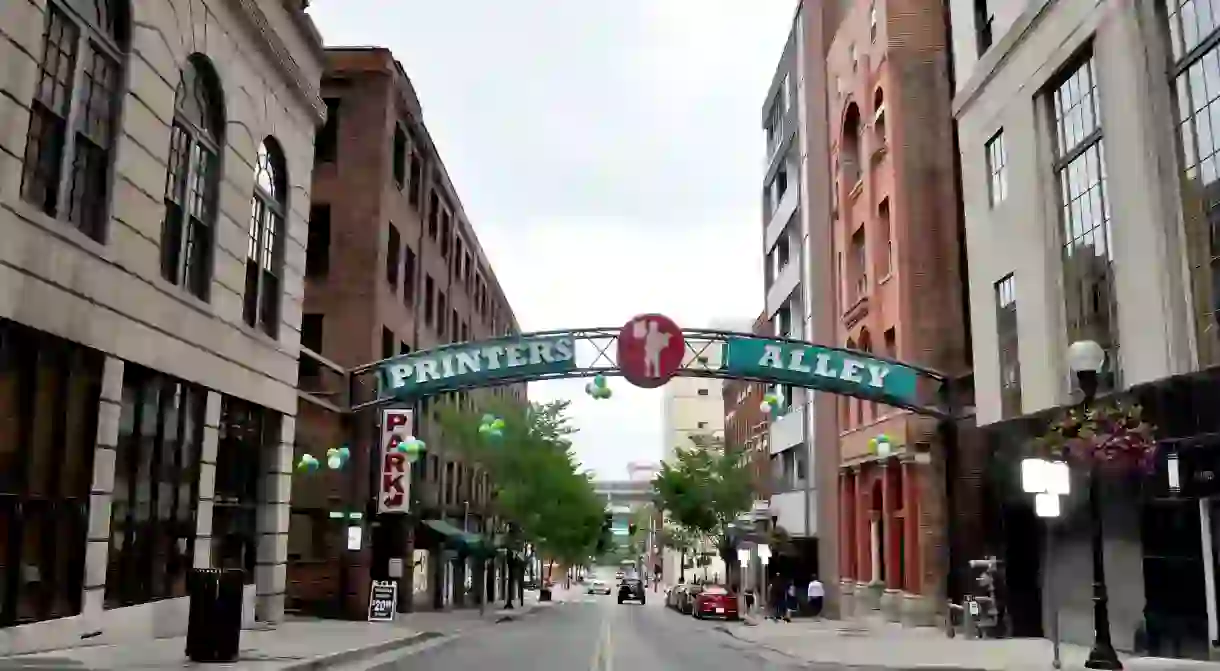A Brief History of Printers Alley, Nashville

If you spend an evening downtown in Nashville, there’s a chance you’ll pass by Printers Alley. This infamous but lesser-known area has quite a fascinating history.
Hidden away between Third Avenue and Fourth Avenue in downtown Nashville is Printers Alley. The part of the alley that runs between Union Street and Church Street first became a nightclub district in the 1940s. When the nightclubs opened, the alley became a place where performers like Chet Atkins, Waylon Jennings, Hank Williams, and Dottie West made their mark. During this time, the sale of liquor for consumption on premises was illegal in Nashville. However, establishments in Printers Alley served it anyway, claiming it had been brown bagged by customers.
The name “Printers Alley” comes from Nashville’s connection to the printing and publishing industries. At the start of the 20th century, the alley was home to two large newspapers, 10 print shops, and 13 publishers. The area became the center of Nashville’s nightlife, servicing the restaurants and hotels on Fourth Avenue, which became known as the Men’s Quarter. As late as the 1960s, Nashville was home to over 36 printing companies.

There was once a venue in Printers Alley called the Rainbow Room, and the owner was David “Skull” Schulman. He was loved so much by other Nashvillians that the Nashville City Council declared him “The Mayor of Printers Alley.” Originally, the Rainbow Room was an exotic dance club that “Skull” eventually converted to a country bar in the 1990s. Prior to its conversion, the club was the only venue in Nashville that had a live band performing music for its dancers.
Tragically, one night in 1998, Schulman was attacked and murdered by two assailants while he was working alone at the club. The killers were eventually caught, but his club didn’t reopen. Bourbon Street Blues and Boogie Bar rented the space for storage for a while, but none of the employees wanted to go in there. Many swore that they saw a shape resembling “Skull” walking around the club and could hear his voice calling out to them.
http://instagram.com/p/BRPXjb1D0im/?tagged=printersalley
After being closed for nearly 20 years following Schulman’s death, the Rainbow Room (now called Skull’s Rainbow Room) reopened in June 2015, thanks to Nashville businessman Phil Martin, who also owns Bourbon Street Blues and Boogie Bar. It’s now a 140-seat bar and restaurant that pays tribute to Schulman and features two of his jackets, which are framed and displayed on a wall. The original checkerboard stage is still in use, and the black-and-white television that “Skull” watched wrestling matches on sits on a shelf inside.
Today, Printers Alley is made up of several venues, such as the Bourbon Street Blues and Boogie Bar, the Fiddle and Steel Guitar Bar, Lonnie’s Western Room, Ms. Kelli’s, Fleet Street Pub, and The Brass Stables. These clubs encompass two live band bars, two karaoke bars, a soccer bar, and one adult entertainment bar.














